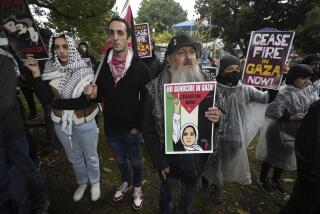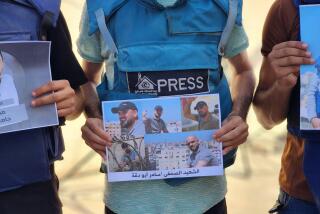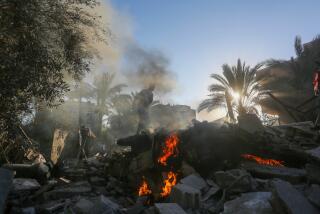Voice for Israel’s Enemy
RAMALLAH, West Bank — Three types of journalists crammed into the living room with the mourning mother of a suicide bomber: Palestinian reporters, the foreign press and Amira Hass.
While others peppered Wasfiyeh Idris with questions about her dead daughter, Hass held back. She spoke in quiet Arabic with friends of Wafa Idris, the first female suicide bomber in the Palestinian uprising, and took discreet notes in Hebrew.
“I didn’t immediately tell them I am an Israeli,” Hass said. “It wasn’t for security; it was because I didn’t want to change the course of events. Whenever they hear I am an Israeli or Jewish, either they become more polite or tougher. I prefer to listen to others and not to be a player.”
A reporter and columnist for the daily newspaper Haaretz, Hass is the only Israeli Jew known to be living under Palestinian rule and one of a handful of Jewish reporters who still cross enemy lines for the Israeli media. As such, she is widely read in Israeli political circles, if not always admired.
Hass says her beat is the “Israeli occupation.” She chronicles Israel’s recent military thrusts into Ramallah and West Bank refugee camps. She records the lives of ordinary Palestinians as they struggle with checkpoints and the army’s demolition of houses and farms. She illustrates the day-to-day impact of Israel’s economic chokehold on Palestinian territories. In short, she provides an unrelenting account of Palestinians as the victims of Israeli domination.
In doing so, Hass is celebrated by some Israelis as a national conscience and condemned by others as an ideologue or even a traitor.
The Israeli-Palestinian conflict is a war of dueling narratives about who is the aggressor, who is the victim and who is the rightful heir to the land. To supporters, Hass provides a necessary alternative to the government’s version of events in the bloody battle. But by presenting the Palestinian point of view, she is seen by some Israelis as arming the enemy.
“In a direct way, she is justifying what she calls the Palestinian struggle. She is justifying the way they butcher us every day,” said Nadav Haetzni, a columnist for the newspaper Maariv who opposes the creation of a Palestinian state.
Yisrael Medad, former director of the right-of-center Israel’s Media Watch, said Hass has adopted the position of “the other side” and should not be writing news.
“I don’t know whether psychologically she is being held hostage, but definitely a Stockholm syndrome of identifying with the enemy is apparent,” Medad said. “If there is shooting from [the West Bank city of] Ramallah into [the neighboring Jewish settlement of] Psagot, she will never go into Psagot to see what the shots did.”
Hass responds that many Israeli reporters cover Israelis who are victims of the 17-month intifada, or uprising, as well as their government’s account of what the Palestinian Authority does. She says Israelis do not get enough information about what their government and army are doing in the West Bank and Gaza Strip.
“Journalism is not about telling people what they like to hear. . . . The task of journalists is to monitor power and, in the relations between Israelis and Palestinians, Israel is certainly the center of power,” Hass said.
She conceded that “nobody would go live in occupied territory without an ideology against occupation,” but she rejected the idea that this disqualified her as an observer. “By the same token, any Israeli journalist who has been a soldier, who used to be in military intelligence or who is in the reserves should be dismissed. There’s no end to it.”
Military service is obligatory in Israel, and many military or national security reporters are former members of intelligence units.
Hass, 45, was born in Jerusalem to Eastern European parents, militant Communists and Holocaust survivors who raised her on what she called “epics of resistance.” She has written that she was haunted by her mother’s memory of German women watching from the sidelines while prisoners were herded into concentration camps and decided “that my place was not with the bystanders.”
A 1993 Move to Gaza--the Lion’s Den
So Hass moved to Gaza City in 1993, a step her Israeli friends considered crazy if not downright suicidal. To most Israelis, Gaza was--and is--the lion’s den, a pit of destitute Palestinians bent on the destruction of Israel.
From Gaza, she covered the Israeli army’s withdrawal in 1994 after the signing of the 1993 Oslo peace accords, and the Palestinians’ early optimism and then gradual desperation as the agreement failed to deliver freedom and statehood. She wrote of her experiences in “Drinking the Sea at Gaza: Days and Nights in a Land Under Siege” before moving to Ramallah in 1997.
Whether they agree with Hass’ definition of journalism, most people who are familiar with her work acknowledge that she is taking great risks. She lives alone in Ramallah, where a mob lynched two Israeli soldiers in October 2000. When Israeli tanks and troops stormed the city this week, she moved to a friend’s house to be closer to the combat. She does not need a translator and frequently works by herself in refugee camps, at demonstrations and in other potentially hostile situations.
After a decade covering the West Bank and Gaza Strip, Hass is well known to officials in the Palestinian Authority and to leaders of armed groups, such as Hamas and the Popular Front for the Liberation of Palestine, that attack Israelis. But ordinary Palestinian rock throwers and Molotov bomb makers--the street fighters who feel that they have nothing to lose--do not necessarily know Hass or what she writes, increasing her risk.
She wears modest clothes and has an unaggressive manner when working among Palestinians. She listens to them intently, as if by that very act she can somehow compensate for decades of miscommunication. She is less likely to be suspected of spying for Israel’s General Security Service than a man might be. But still, she spends her time exploring the recesses of a heavily armed society at war with her country. She would be an easy target for the men--and now, perhaps, women--willing to die to kill Israelis. More important, as the siege of the Palestinian territories tightens, she is more accessible than most Israelis.
Hass does not like to discuss the risks, saying only that there have been two or three incidents in which she was seriously threatened and that in each case people came to her rescue.
But her Israeli colleagues testify to the danger of covering the Palestinian territories during the uprising. About 1,400 people, the majority of them Palestinians, have died in the violence.
“Before this intifada, an Israeli journalist was generally welcomed by the Palestinians. Even if I wanted to talk to Hamas leaders, I felt secure,” said Yoram Binur of Channel 2 television. “I used to do my work in Ramallah, then have lunch or dinner there to talk to real people and get the atmosphere. Now I do the work and run.”
Gideon Levy, a colleague of Hass at Haaretz, says he also seeks to tell the story of the Israeli occupation, in a weekly column called “Twilight Zone.” He still dips in and out of the Palestinian territories, but visits fewer and fewer places.
“I risk my life every week. Amira risks her life every day,” Levy said.
But for what are they risking their lives? That is a question asked by many Israelis.
Haaretz is the smallest of three major Israeli dailies, with a midweek circulation of about 70,000, compared with 400,000 for Yediot Aharonot and 220,000 for Maariv. Haaretz is also the most left-wing daily in an increasingly conservative country. Some critics argue that Hass and Levy simply preach to the choir, to a small group of highly educated elites who believe that the creation of a Palestinian state is the way the two peoples will live in peace.
Even some Israelis who share Hass’ political views find her accounts of Palestinian suffering predictable. Whether it is because they are painful, painstakingly repetitive or perceived to be self-righteous, the articles are too much for many Israelis.
Government spokesman Raanan Gissin dismisses Hass’ work as “writing under the gun”--exercising self-censorship to remain on the ground. Many media critics and opinion makers, however, say she and Levy make a unique contribution to Israeli journalism.
“I know they’re not going to tell me about a soldier who was humane at the roadblock because it doesn’t fit. It is a waste of paper to them,” said Uri Dromi, who served as spokesman for the late Prime Minister Yitzhak Rabin. “But bad things happen in wars, and we should know about them. Then we make up our minds when we are informed rather than ill-informed.”
Hass interviewed an Israeli soldier last fall who revealed that the army had forbidden sharpshooters to target children but that it defined children as those younger than 12. “Twelve and up is allowed. He’s not a child anymore,” the sharpshooter said. “That’s what they tell us.”
On Thursday, Hass went back to the house where she had met Idris’ mother to cover another wake, this one for a 15-year-old boy killed in the combat.
In other articles, she has given blow-by-blow accounts of the army’s demolition of a Palestinian building in Al Birah and a look at Palestinians whose house was leveled in Rafah. She spent a day at an army checkpoint in Al Birah during a closure, recording the haggling, supplication and defeat of Palestinians trying to get out.
One recent afternoon, she spent hours listening to the Palestinian leaders of neighborhoods that fall within the annexed boundaries of Jerusalem but are beyond the outermost army checkpoint in the city. One by one, they told her how they pay city taxes and telephone bills but cannot get services because workers and repair crews say it is too dangerous to come into their neighborhoods.
Levy, meanwhile, has reported on the deaths of two Palestinian newborns whose pregnant mothers were barred by soldiers from going through checkpoints to get to the hospital. In one of his most controversial pieces, he interviewed the Palestinian police chief in Ramallah after the two Israeli soldiers were lynched at the police headquarters. He gave the commander’s account of what happened to an Israeli public with no more stomach for explanations than Americans had after the Sept. 11 attacks.
Hass and Levy have cost Haaretz “a few dozen” subscriptions, according to Managing Editor Yoel Esteron.
Media Seen as Siding With Palestinian Cause
Israel Harel, an advocate for Jewish settlers in the West Bank and Gaza Strip and a fellow columnist at Haaretz, refuses to discuss his colleagues except to say that he believes that most of the Israeli media side “with the Palestinians’ cause.” By way of example, he says that they have adopted the Palestinian term “Al Aqsa intifada” for the uprising that began after Ariel Sharon, then an opposition politician and now prime minister, paid a visit to the Al Aqsa mosque area of Jerusalem with a contingent of heavily armed security guards.
“I consider this a war of terror,” Harel said. “Once the press calls it by the name they want it to be called, their cause is more right than our cause.”
Language is a weapon in all wars, and no less so in the Israeli-Palestinian conflict. The West Bank, which Israel captured in 1967, is called Judea and Samaria by those Israelis who claim that they have a biblical right to it. Hard-line Palestinians who do not recognize Israel’s right to exist call the Jewish state the “Zionist entity.”
Palestinians call suicide bombers shahid, or martyr, while Israelis call the killings that the army carries out “targeted preventions.”
The Israeli army speaks of closures and curfews, but former Rabin spokesman Dromi considers them sterile words that do not relate to events on the ground.
That’s where Hass comes in.
“Amira tells Israelis what lies behind the words,” he said.
More to Read
Sign up for Essential California
The most important California stories and recommendations in your inbox every morning.
You may occasionally receive promotional content from the Los Angeles Times.










